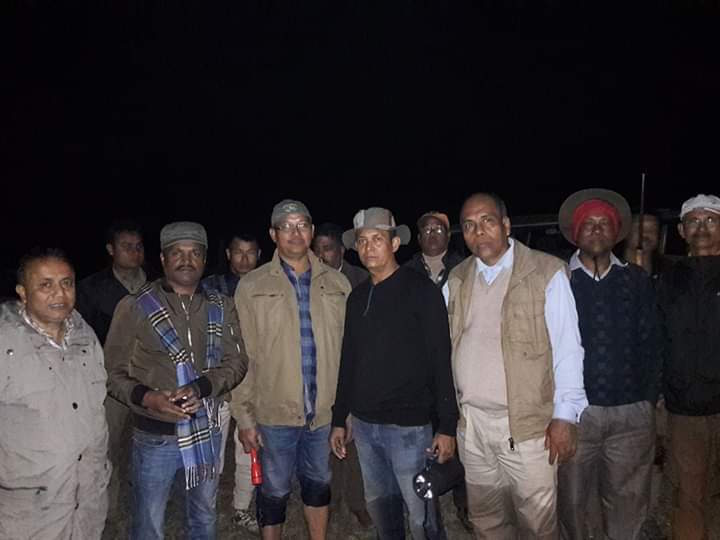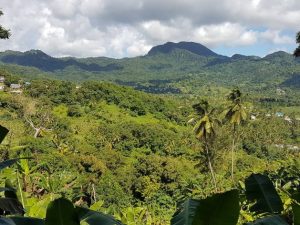by Sahana Ghosh on 19 February 2020
• Identification of smaller forest pockets that still hold high levels of biodiversity is essential for conservation.
• Connecting smaller protected forests to larger ones can ensure movement of animals so that there is an exchange of genetic material, which will ensure long term sustainability of the populations.
• Fragmented non-protected forest patches, such as those in the northern Western Ghats, should also be given high conservation priority, because of the diversity of specific species. Indian forest officer Rai Singh Jhala skirts the edge of the Monsoon Palace at Sajjangarh, perched high in the Aravalli hills just outside Udaipur city, in the west Indian state of Rajasthan.
Tracing the spread of the Sajjangarh Wildlife Sanctuary (WLS) that surrounds the hill-top palace, he takes in the panoramic view of the Fateh Sagar Lake and the urban sprawl of the city of lakes. There is pride in the 59-year-old’s voice as he says: “It is a tiny patch of forest but is precious to us.”
At 5.19 square km, the sanctuary, a walled protected area, is the smallest in Rajasthan, the largest state in India by area. It is home to small mammals such as panthers, striped hyenas, jackals, spotted deer, sambhar and at least six species of small cats (desert cat, jungle cat) among other species. Thanks to its avian diversity, the area is also a popular birding spot, observed Jhala.
In the foothills of the WLS, lies the recently-notified Sajjangarh Biological Park in an area of 36 hectares (0.36 square km) of unclassed forest land. The park and the sanctuary, which includes the palace in its limits, have been strong revenue generators through tourism, said officials.
“The community also recognises the importance of conservation and is mindful of not cutting trees for firewood inside the area. If they need something they usually ask. The sanctuary and the park are the lungs of the city,” explained Jhala, adding that the forest patch benefits its small inhabitants.
“There are some species such as tigers that are landscape species which require larger areas for survival. But for small species such as wild cats etc their home range is very small. Every population is important. They contribute a lot to the ecosystem. So if you remove the wild cats from the sanctuary then the population of rodents may go up,” explained GV Reddy, chairperson of the Rajasthan State Biodiversity Board and principal chief conservator of forest (head of forest force).
Conservation biologist Mousumi-Ghosh Harihar who currently works at the National Centre for Biological Sciences, Tata Institute of Fundamental Research, emphasised the identification of smaller pockets that still hold high levels of biodiversity, whether they hold invertebrates or smaller animals or charismatic species.
However, Ghosh-Harihar said reduced genetic diversity is one of the negative effects of small, stand-alone areas, which is why connecting them to larger forest patches is integral for long-term conservation goals.
“For example, you also have the Gibbon Wildlife Sanctuary named after hoolock gibbon that covers an area of 20.98 square kilometres in Assam. It is small but it has old-growth rainforest and seven species of primates. Such isolated populations often have problems of [low] genetic variability and inbreeding etc,” she said.
In the context of conserving biodiversity, the focus should be on identifying smaller patches that can be connected to larger ones, to ensure animals can move between the patches to exchange genetic material. Such intermixing of smaller populations ensures long-term sustenance of the species in the region.
“So the emphasis should be on promoting land uses around it [the smaller patches] in collaboration with the local community so that there is a chance of the populations being able to disperse from one patch to the other,” said Ghosh-Harihar.

Ghosh-Harihar and co-authors in the review ‘Protected areas and biodiversity conservation in India’ suggest more studies of the landscape matrix in which protected areas are embedded, especially as many protected areas are relatively small and connectivity is a major issue.
When a small population is isolated (e.g. Panna, Sariska) chances of it being able to withstand sudden losses due to stochastic events (e.g. illegal poaching, disease, some environmental catastrophe) are very low, she said. “Of course, even without these, such populations may lose out as genetic variation is lost in the course of time which might reduce their ability to adapt to changes in the future,” added Ghosh-Harihar.
As of July 2019, India has 870 protected areas covering 165,088.36 sq. km, which is five percent of the total geographic area of the country. However, 21.67 percent of India’s total geographical area is under forest cover.
In the sixth National Report to the Convention of Biological Diversity submitted in December 2018, India said that with “well over 20 percent of its total geographical area under biodiversity conservation, India has exceeded the terrestrial component of 17 percent of Aichi target 11, and 20 percent of corresponding National Biodiversity Target relating to areas under biodiversity management.”
At the summit of the Convention on Biological Diversity (CBD) in China this October, governments will hash out a framework for biodiversity protection over the coming decade, replacing the 2020 Aichi targets.
Urban forests for education and well-being
A small isolated patch in an urban area can still hold interesting species and can be good for educational purposes. “But it’s difficult to sustain those populations, particularly for species which require larger areas, over longer time periods if they are completely isolated and we can’t maintain connectivity with larger populations. But they hold their value for conserving many other smaller species and are really good for educating the public and just giving them an experience of biodiversity,” said Ghosh-Harihar.
Urban forest or green patches also provide important ecosystem services: countering urban heat island effect, sponging off stormwater runoff, and contributing to residents’ social and psychological well-being. In metropolitan cities such as Kolkata, expansion and extension of the city’s limit by the construction of satellite townships has drastically changed the peri-urban vegetation cover since 2000. As large, open green spaces were converted to settlements, peri-urban agriculture system took a hit.
“In the peri-urban agriculture system, green patches of surrounding agriculture field are crucial to productivity. The green patches are also important in maintaining the ecosystem value chains in the peri-urban agriculture fields,” Subha Chakraborty of the department of architecture, town and regional planning at Indian Institute of Engineering Science and Technology, Shibpur, told Mongabay-India.
In the city and surrounding areas, overall, the green space has shrunk over the last 43 years (1977-2020), he said.
“In the area under Kolkata Metropolitan Development Authority, the statutory planning and development authority for the Kolkata Metropolitan Area, open green spaces have been squished into around 720 parks and over four decades the type of vegetation has also changed,” Chakraborty added.
Read more: Urban heat island effect in India’s major cities.
In India, many of the forest patches that are connected to larger areas are also at risk of being wiped out from developmental pressures.
An urban forest in Mumbai, Aarey Milk Colony, has recently been at the centre of a heated battle between metro rail authorities and activists over the construction of a metro car shed. Aarey falls within the eco-sensitive zone of Sanjay Gandhi National Park (SGNP) and sprawls over 1,300 hectares (13 square km) in the city’s suburbs. The forests of Aarey link the hills surrounding Mumbai and SGNP, allowing for movement and gene flow.
Aarey’s trees, grassland, bushes and marshes are home to leopards, migratory birds, snakes, scorpions, spiders, butterflies and more species. In Aarey, at any given time there are about four to five adult leopards, including a transient population that moves between Aarey and SGNP.
The government claims that Aarey is not a notified forest and hence the land can be used by the government for the metro project but the activists claim otherwise, expressing concern that the project will destroy Mumbai’s “green lungs” and floodplains of Mithi river.
Notifications can’t always guarantee compliance. For example, despite the notified 29.79 square km eco-sensitive zone surrounding the Sajjangarh Wildlife Sanctuary, tourism associated construction has breached zone barriers.
Biodiversity rich non-protected forest patches in peril
For non-protected forests, the absence of restrictions makes them much more vulnerable to anthropogenic activities, said authors in a 2019 study on the fragmented non-protected forest in the northern Western Ghats.
The northern Western Ghats (NWG) is a patchy continuum of forests that have been severely fragmented, primarily due to human actions. The study documented the flowering plants in a representative fragmented forest patch of NWG and reported 157 species of flowering plants including 49 tree species from the area of 0.3ha. The number of tree species recorded in the study constitutes 11 percent of the total native tree species of Maharashtra.
It recommends that owing to their high diversity, the fragmented non-protected forest patches of the region should also be given high conservation priority because even such small fragmented forest patches could also harbour a high diversity of flowering plants and that they need to be conserved by increasing awareness of the local communities and vigilance for destructive activities. “This would aid in conserving the biodiversity of the entire region as a whole,” the study notes.
Even sacred groves where specific groups of trees on forest land are preserved for their socio-cultural and religious importance are relics of old-growth forests that once stood in the region. They are maintained and protected by the local indigenous communities because they are integral to their culture and religious beliefs. In addition to preserving biodiversity, they are crucial to the continuance of tribal legacy.
Read more: Faith and healing in the sacred groves of Madhya Pradesh
For example, Meghalaya has 125 sacred groves and these tracts range from 0.01 to 900 hectares in area. Spread over an estimated 1,000 square km of forest areas under the administrative control of local district councils, they have been preserved through the ages by the indigenous tribal communities.
However, according to the Meghalaya forest department, sacred groves in the state are now increasingly coming under threat as the tribal way of life changes. The area under sacred groves is also shrinking and quite a few have been turned into degraded forests. Some sacred groves though protected in the past have fallen prey to encroachments and degradation due to decline of the very social and ethical values that had helped them to thrive, the forest department notes.
Private conservation reserves, like the one in Sawai Madhopur in Rajasthan (pictured below), have added on to the league of smaller areas that are aiding in biodiversity conservation outside the country’s notified protected area network. – Mongabay India
Small but precious: small forest patches act as islands and corridors of biodiversity




